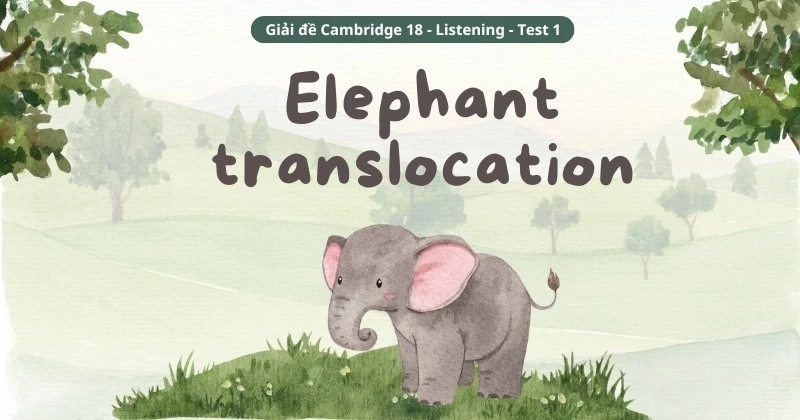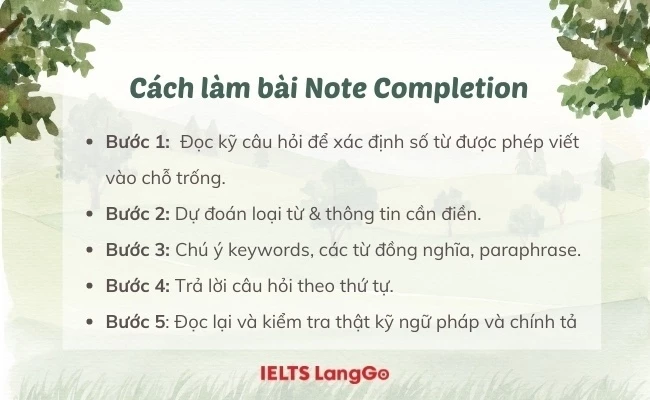


Phần 4 của bài thi IELTS Listening thường được nhận xét là phần gây nhiều khó khăn nhất cho các thí sinh. Các dạng bài ở phần này thường đòi hỏi nhiều về khả năng nghe hiểu và chọn lọc thông tin. Vì vậy, IELTS LangGo sẽ mang đến cho bạn phần đề bài, transcript và giải thích đáp án chi tiết cho đề Cambridge 18 Listening Test 1 Part 4: Elephant translocation. Chúng ta hãy cùng luyện tập nhé!
Question 31-40
Complete the notes below. Write ONE WORD ONLY for each answer.
Reasons for overpopulation at Majete National Park
strict enforcement of anti-poaching laws
successful breeding
Problems caused by elephant overpopulation
greater competition, causing hunger for elephants
damage to 31.............................. in the park
The translocation process
a suitable group of elephants from the same 32............................. was selected
vets and park staff made use of 33.............................. to help guide the elephants into an open plain
elephants were immobilised with tranquilisers
this process had to be completed quickly to reduce 34...............................
elephants had to be turned on their 35................................ to avoid damage to their lungs
elephants' 36.................................. had to be monitored constantly
tracking devices were fitted to the matriarchs
data including the size of their tusks and 37................................... elephants were taken by truck to their new reserve
Advantages of translocation at Nkhotakota Wildlife Park
38.............................. opportunities
a reduction in the number of poachers and 39...............................
an example of conservation that other parks can follow
an increase in 40................................ as a contributor to GDP

Phân tích đề bài và chiến lược làm bài:
Bài tập này bao gồm 10 câu, thuộc dạng Note Completion
Chiến lược làm bài dạng Note Completion:
Bước 1: Đọc kỹ câu hỏi để xác định số từ được phép viết vào chỗ trống và tiêu đề.
Bước 2: Dự đoán loại từ & thông tin cần điền.
Bước 3: Chú ý keywords, các từ đồng nghĩa, paraphrase và những từ ngữ gây phân tâm.
Bước 4: Trả lời câu hỏi theo thứ tự.
Bước 5: Kiểm tra thật kỹ ngữ pháp và chính tả bằng cách đọc lại cả câu sau khi điền đáp án.
Sau khi thực hành, các bạn hãy nghe lại audio trong khi check transcript để có thể check lại những đoạn mình nghe chưa rõ, đồng thời luyện tậm cách phát âm và mở rộng vốn từ nhé!
| For my presentation today I want to tell you about how groups of elephants have been moved and settled in new reserves. This is known as translocation and has been carried out in Malawi in Africa in recent years. The reason this is being done is because of overpopulation of elephants in some areas. Overpopulation is a good problem to have and not one we tend to hear about very often. In Malawi’s Majete National Park the elephant population had been wiped out by poachers, who killed the elephants for their ivory. But in 2003, the park was restocked and effective law enforcement was introduced. Since then, not a single elephant has been poached. In this safe environment, the elephant population boomed. Breeding went so well that there were more elephants than the park could support. This led to a number of problems. Firstly, there was more competition for food, which meant that some elephants were suffering from hunger. As there was a limit to the amount of food in the national park, some elephants began looking further afield. Elephants were routinely knocking down fences around the park, which then had to be repaired at a significant cost. (31) To solve this problem, the decision was made to move dozens of elephants from Majete National Park to Nkhotakota Wildlife Park, where there were no elephants. But, obviously, attempting to move significant numbers of elephants to a new home 300 kilometres away is quite a challenge. So how did this translocation process work in practice? Elephants were moved in groups of between eight and twenty, all belonging to one family. (32) Because relationships are very important to elephants, they all had to be moved at the same time. A team of vets and park rangers flew over the park in helicopters and targeted a group, which were rounded up and directed to a designated open plain. (33) The vets then used darts to immobilise the elephants – this was a tricky manoeuvre, as they not only had to select the right dose of tranquiliser for different-sized elephants but they had to dart the elephants as they were running around. This also had to be done as quickly as possible so as to minimise the stress caused. As soon as the elephants began to flop onto the ground, the team moved in to take care of them. (34) To avoid the risk of suffocation, the team had to make sure none of the elephants were lying on their chests because their lungs could be crushed in this position. So all the elephants had to be placed on their sides. (35) One person stayed with each elephant while they waited for the vets to do checks. It was very important to keep an eye on their breathing – if there were fewer than six breaths per minute, the elephant would need urgent medical attention. (36) Collars were fitted to the matriarch in each group so their movements could be tracked in their new home. Measurements were taken of each elephant’s tusks – elephants with large tusks would be at greater risk from poachers – and also of their feet (37). The elephants were then taken to a recovery area before being loaded onto trucks and transported to their new home. The elephants translocated to Nkhotakota settled in very well and the project has generally been accepted to have been a huge success – and not just for the elephants. Employment prospects have improved enormously, contributing to rising living standards for the whole community. (38) Poaching is no longer an issue, as former poachers are able to find more reliable sources of income. In fact, many of them volunteered to give up their weapons, as they were no longer of any use to them. (39) More than two dozen elephants have been born at Nkhotakota since relocation. With an area of more than 1,800 square kilometres, there’s plenty of space for the elephant population to continue to grow. Their presence is also helping to rebalance Nkhotakota’s damaged ecosystem and providing a sustainable conservation model, which could be replicated in other parks. All this has been a big draw for tourism, which contributes five times more than the illegal wildlife trade to GDP, and this is mainly because of the elephants (40). There’s also been a dramatic rise in interest … |
Sau đây là đáp án của bài Elephant translocation - IELTS Listening:
| 31 | fences | 36 | breathing |
| 32 | family | 37 | feet |
| 33 | helicopters | 38 | employment |
| 34 | stress | 39 | weapons |
| 35 | sides | 40 | tourism |
Đáp án: fences
Keywords trong câu hỏi: Problems caused by elephant overpopulation
- damage to 31 _____ in the park
Keywords trong bài nghe:
This led to a number of problems. [...] Elephants were routinely knocking down fences around the park, which then had to be repaired at a significant cost.
Giải thích: Khi nhắc đến những vấn đề do quá tải số lượng voi (a number of problems), bên cạnh việc một số con voi phải chịu đói ( some elephants were suffering from hunger), chúng còn thường húc đổ hàng rào quanh công viên (Elephants were routinely knocking down fences around the park)
Đáp án: family
Keywords trong câu hỏi: The translocation process
– a suitable group of elephants from the same 32 _____ was selected
Keywords trong bài nghe: So how did this translocation process work in practice?
Elephants were moved in groups of between eight and twenty, all belonging to one family.
Giải thích: Để trả lời câu hỏi cho quá trình vận chuyển voi (So how did this translocation process work in practice?), những con voi được vận chuyển theo nhóm (Elephants were moved in groups), tất cả đều ở trong cùng một gia đình (all belonging to one family)
Đáp án: helicopters
Keywords trong câu hỏi:
– vets and park staff made use of 33 _____ to help guide the elephants into an open plain
Keywords trong bài nghe:
A team of vets and park rangers flew over the park in helicopters and targeted a group, which were rounded up and directed to a designated open plain.
Giải thích: Các nhân viên thú y và nhân viên trong công viên (A team of vets and park rangers) đã bay qua công viên bằng trực thăng (flew over the park in helicopters) để chỉ đường cho nhóm voi đến bãi đất trống được chỉ định (directed to a designated open plain)
Đáp án: stress
Keywords trong câu hỏi: elephants were immobilised with tranquilisers
– this process had to be completed quickly to reduce 34 _____
Keywords trong bài nghe:
The vets then used darts to immobilise the elephants -this was a tricky manoeuvre, as they not only had to select the right dose of tranquiliser for different-sized elephants but they had to dart the elephants as they were running around. This also had to be done as quickly as possible so as to minimise the stress caused. As soon as the elephants began to flop onto the ground, the team moved in to take care of them.
Giải thích: Khi nói về việc gây mê cho voi (The vets then used darts to immobilise the elephants), hành động cần được diễn ra nhanh chóng (This also had to be done as quickly as possible) để giảm sự căng thẳng gây ra cho chúng (to minimise the stress caused)
Đáp án: sides
Keywords trong câu hỏi:
– elephants had to be turned on their 35 _____ to avoid damage to their lungs
Keywords trong bài nghe:
To avoid the risk of suffocation, the team had to make sure none of the elephants were lying on their chests because their lungs could be crushed in this position. So all the elephants had to be placed on their sides.
Giải thích: để tránh việc phổi của những con voi bị dập (their lungs could be crushed), tất cả số voi cần được đặt nằm nghiêng (all the elephants had to be placed on their sides).
Đáp án: breathing
Keywords trong câu hỏi:
elephants’ 36 _____ had to be monitored constantly
Thông tin cần tìm: danh từ - một thứ của con voi cần được giám sát
Keywords trong bài nghe:
One person stayed with each elephant while they waited for the vets to do checks. It was very important to keep an eye on their breathing – if there were fewer than six breaths per minute, the elephant would need urgent medical attention.
Giải thích: Việc theo dõi nhịp thở của những con voi là rất quan trọng (It was very important to keep an eye on their breathing)
Đáp án: feet
Keywords trong câu hỏi:
– data including the size of their tusks and 37 _____ was taken
Keywords trong bài nghe:
Measurements were taken of each elephant’s tusks - elephants with large tusks would be at greater risk from poachers – and also of their feet.
Giải thích: Kích cỡ được đo ở chiếc vòi, cũng như ở chân của chúng (Measurements were taken of each elephant’s tusks … and also of their feet)
Đáp án: Employment
Keywords trong câu hỏi: Advantages of translocation at Nkhotakota Wildlife Park
38 _____ opportunities
Keywords trong bài nghe:
The elephants translocated to Nkhotakota settled in very well and the project has generally been accepted to have been a huge success – and not just for the elephants. Employment prospects have improved enormously, contributing to rising living standards for the whole community.
Giải thích: Sau khi di chuyển những con voi đến Nkhotakota (The elephants translocated to Nkhotakota), tiềm năng về việc làm đã phát triển đáng kể (Employment prospects have improved enormously)
Đáp án: weapons
Keywords trong câu hỏi:
a reduction in the number of poachers and 39 _____
Thông tin cần tìm: danh từ - một vật bị giảm về số lượng
Keywords trong bài nghe:
Poaching is no longer an issue, as former poachers are able to find more reliable sources of income. In fact, many of them volunteered to give up their weapons, as they were no longer of any use to them.
Giải thích: Việc săn bắt trái phép không còn là một vấn đề (Poaching is no longer an issue), nhiều người đi săn đã giao nộp lại vũ khí (many of them volunteered to give up their weapons)
Đáp án: tourism
Keywords trong câu hỏi:
an example of conservation that other parks can follow
an increase in 40 _____ as a contributor to GDP
Thông tin cần tìm: danh từ - một lĩnh vực kinh tế
Keywords trong bài nghe:
Their presence is also helping to rebalance Nkhotakota’s damaged ecosystem and providing a sustainable conservation model, which could be replicated in other parks. All this has been a big draw for tourism, which contributes five times more than the illegal wildlife trade to GDP, and this is mainly because of the elephants. There’s also been a dramatic rise in interest
Giải thích: Một mô hình bảo tồn bền vững (a sustainable conservation model) có thể được nhân rộng ở các công viên khác (could be replicated in other parks). Điều này mang lại lợi ích lớn cho ngành du lịch (this has been a big draw for tourism) - mang lại sự đóng góp cao hơn 5 lần so với việc buôn bán động vật hoang dã trái phép cho GDP (contributes five times more than the illegal wildlife trade to GDP)
Ở trên là phần Đáp án và giải thích chi tiết đề Cambridge 18 Listening Test 1 Part 4: Elephant translocation. Không chỉ Listening mà dù là kỹ năng nào cũng sẽ đòi hỏi sự trau dồi và luyện tập kỹ càng để đạt được tiến bộ. Chúc các bạn luôn có thật nhiều năng lượng để có thể chinh phục mục tiêu IELTS của mình nhé!



ĐẶT LỊCH TƯ VẤN MIỄN PHÍ LỘ TRÌNH Săn ƯU ĐÃI lên tới 12.000.000đ